Chapter 4 - Linear Equations in Two Variables Exercise Ex. 4.1
Solution 1
Let cost of notebook and a pen be x and y respectively.
Cost of note book = 2  cost of pen
cost of pen
x = 2y
x - 2 y = 0
 cost of pen
cost of pen x = 2y
x - 2 y = 0
Solution 2
(i) 
Comparing this equation with ax + by + c = 0
(ii) 
Comparing this equation with ax + by + c = 0
a = 1, b = -  , c = -10
, c = -10
 , c = -10
, c = -10
(iii) - 2x + 3 y = 6
- 2x + 3 y - 6 = 0
- 2x + 3 y - 6 = 0
Comparing this equation with ax + by + c = 0
a = - 2, b = 3, c = - 6
a = - 2, b = 3, c = - 6
(iv) x = 3y
1x - 3y + 0 = 0
Comparing this equation with ax + by + c = 0
a = 1, b = - 3, c = 0
1x - 3y + 0 = 0
Comparing this equation with ax + by + c = 0
a = 1, b = - 3, c = 0
(v) 2x = - 5y
2x + 5y + 0 = 0
2x + 5y + 0 = 0
Comparing this equation with ax + by + c = 0
a = 2, b = 5, c = 0
a = 2, b = 5, c = 0
(vi) 3x + 2 = 0
3x + 0.y + 2 = 0
3x + 0.y + 2 = 0
Comparing this equation with ax + by + c = 0
a = 3, b = 0, c = 2
a = 3, b = 0, c = 2
(vii) y - 2 = 0
0.x + 1.y - 2 = 0
0.x + 1.y - 2 = 0
Comparing this equation with ax + by + c = 0
a = 0, b = 1, c = - 2
a = 0, b = 1, c = - 2
(viii) 5 = 2x
- 2x + 0.y + 5 = 0
Company this equation with ax + by + c = 0
a = - 2, b = 0, c = 5
- 2x + 0.y + 5 = 0
Company this equation with ax + by + c = 0
a = - 2, b = 0, c = 5
Chapter 4 - Linear Equations in Two Variables Exercise Ex. 4.2
Solution 1
y = 3x + 5 is a linear equation in two variables and it has infinite solutions. As for every value of x there will be a value of y satisfying above equation and vice versa.
Hence, the correct answer is (iii).
Hence, the correct answer is (iii).
Solution 2
(i) 2x + y = 7
For x = 0
2(0) + y = 7
For x = 0
2(0) + y = 7
 y = 7
y = 7
So, (0, 7) is a solution of this equation
For x = 1
For x = 1
2(1) + y = 7
 y = 5
y = 5
So, (1, 5) is a solution of this equation
For x = -1
2(-1) + y = 7
2(-1) + y = 7
 y = 5
y = 5
So, (-1, 9) is a solution of this equation
For x = 2
2(2) + y = 7
 y = 3
y = 3
2(2) + y = 7
 y = 3
y = 3
So (2, 3) is a solution of this equation.
(ii) 
 + y = 9
+ y = 9

 + y = 9
+ y = 9
For x = 0
 (o) + y = 9
(o) + y = 9 y = 9
y = 9
So (0, 9) is a solution of this equation
For x = 1
 (1) + y =9
(1) + y =9
For x = 1
 (1) + y =9
(1) + y =9 y = 9 -
y = 9 - 
So, (1, 9 -  ) is a solution of this equation
) is a solution of this equation
 ) is a solution of this equation
) is a solution of this equation
For x = 2
 (2) + y = 9
(2) + y = 9 y = 9 - 2
y = 9 - 2
So, (2, 9 -2 ) is a solution of this equation
) is a solution of this equation
 ) is a solution of this equation
) is a solution of this equation
For x = -1
 (-1) + y = 9
(-1) + y = 9
y = 9 + 

So, (-1, 9 +  ) is a solution of this equation
) is a solution of this equation
 ) is a solution of this equation
) is a solution of this equation
(iii) x = 4y
For x = 0
0 = 4y
For x = 0
0 = 4y
 y = 0
y = 0
So, (0, 0) is a solution of this equation
For y = 1
x = 4(1) = 4
So, (4, 1) is a solution of this equation
For y = - 1
x = 4(-1)
x = -4
So, (-4, - 1) is a solution of this equation
For x = 2
2 = 4y
For y = 1
x = 4(1) = 4
So, (4, 1) is a solution of this equation
For y = - 1
x = 4(-1)
x = -4
So, (-4, - 1) is a solution of this equation
For x = 2
2 = 4y
y = 

So,
 is a solution of this equation.
is a solution of this equation.
Solution 3
(i) (0, 2)
Putting x = 0, and y = 2 in the L.H.S of given equation
x - 2y = 0 - (2 2 )
2 )
Putting x = 0, and y = 2 in the L.H.S of given equation
x - 2y = 0 - (2
 2 )
2 )
= - 4
As -4 # 4
L.H.S # R.H.S
So (0, 2) is not a solution of this equation.
L.H.S # R.H.S
So (0, 2) is not a solution of this equation.
(ii) (2, 0)
Putting x = 2, and y = 0 in the L.H.S of given equation
x - 2y = 2 - (2 0)
0)
x - 2y = 2 - (2
 0)
0)
= 2
As 2 # 4
L.H.S R.H.S
R.H.S
So (2, 0) is not a solution of this equation.
L.H.S
 R.H.S
R.H.SSo (2, 0) is not a solution of this equation.
(iii) (4, 0)
Putting x = 4, and y = 0 in the L.H.S of given equation
x - 2y = 4 - 2(0)
= 4 = R.H.S
So (4, 0) is a solution of this equation.
Putting x = 4, and y = 0 in the L.H.S of given equation
x - 2y = 4 - 2(0)
= 4 = R.H.S
So (4, 0) is a solution of this equation.
(iv) 

Putting x =  and y = 4
and y = 4 in the L.H.S of given equation.
in the L.H.S of given equation.
 and y = 4
and y = 4 in the L.H.S of given equation.
in the L.H.S of given equation.

L.H.S
 R.H.S
R.H.SSo
 is not a solution of this equation.
is not a solution of this equation.
(v) (1, 1)
Putting x = 1, and y = 1 in the L.H.S of given equation
x - 2y = 1 - 2(1)
Putting x = 1, and y = 1 in the L.H.S of given equation
x - 2y = 1 - 2(1)
= 1 - 2
= - 1
As -1 # 4
L.H.S R.H.S
R.H.S
So (1, 1) is not a solution of this equation.
L.H.S
 R.H.S
R.H.SSo (1, 1) is not a solution of this equation.
Solution 4
Putting x = 2, and y = 1 in the given equation
2x + 3y = k
2(2) + 3(1) = k
4 + 3 = k
k = 7
2(2) + 3(1) = k
4 + 3 = k
k = 7
Chapter 4 - Linear Equations in Two Variables Exercise Ex. 4.3
Solution 1
(i) x + y = 4
We may observe that x = 0, y = 4 and x = 4, y = 0 are solutions of above equation. So our solution table is
| x | 0 | 4 |
| y | 4 | 0 |
Now we may draw the graph of this equation as below.
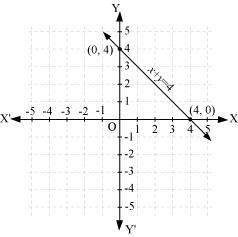
(ii) x - y = 2
We may observe that x = 4, y = 2 and x = 2, y = 0 are solutions of above equation. So our solution table is
| x | 4 | 2 |
| y | 2 | 0 |
Now we can draw the graph of above equation as following
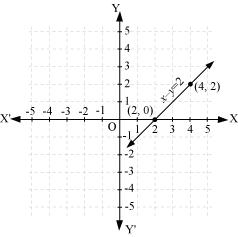
(iii) y = 3x
We may observe that x = - 1, y = - 3 and x = 1, y = 3 are solutions of above equation. So our solution table is
Now we may draw the graph of above equation as following
We may observe that x = - 1, y = - 3 and x = 1, y = 3 are solutions of above equation. So our solution table is
| x | - 1 | 1 |
| y | - 3 | 3 |
Now we may draw the graph of above equation as following

(iv) 3 = 2x + y
We may observe that x = 0, y = 3 and x = 1, y = 1 are solutions of above equation. So our solution table is
| x | 0 | 1 |
| y | 3 | 1 |
Now we may construct the graph of this equation as below
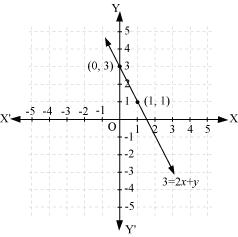
Solution 2
We may observe that point (2, 14) satisfies the equation 7x - y = 0 and
2x + y -18 = 0.
2x + y -18 = 0.
So, 7x - y = 0 and 2x + y - 18 = 0 are two lines passing through point (2, 14).
As we know that through one point, infinite number of lines can pass through.
So, there are infinite lines of such type passing through given point.
As we know that through one point, infinite number of lines can pass through.
So, there are infinite lines of such type passing through given point.
Solution 3
Putting x = 3, y = 4 in the given equation
3y = ax + 7
3 (4) = a (3) + 7
5 = 3a
a =
3y = ax + 7
3 (4) = a (3) + 7
5 = 3a
a =

Solution 4
Total distance covered = x km.
Fair for 1st kilometre = Rs .8
Fair for rest distance = (x - 1) 5
Total fair = 8 + (x - 1) 5
y = 8 + 5x - 5
y = 5x + 3
5x - y + 3 = 0
Fair for 1st kilometre = Rs .8
Fair for rest distance = (x - 1) 5
Total fair = 8 + (x - 1) 5
y = 8 + 5x - 5
y = 5x + 3
5x - y + 3 = 0
We may observe that point (0, 3) and  satisfies the above equation. So these are solutions of this equation.
satisfies the above equation. So these are solutions of this equation.
 satisfies the above equation. So these are solutions of this equation.
satisfies the above equation. So these are solutions of this equation. | x | 0 |  |
| y | 3 | 0 |
Now we may draw the graph of this equation as below
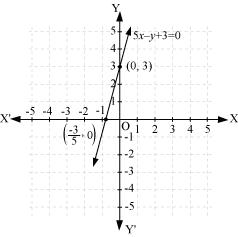
Here we may find that variable x and y are representing the distance covered and fare paid for that distance respectively and these quantities may not be negative. Hence we will consider only those values of x and y which are lying in 1st quadrant.
Solution 5
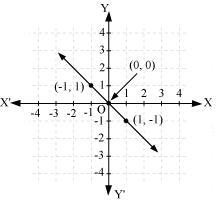
Points on the given line are (- 1, 1), (0, 0), (1, - 1)
We may observe that coordinates of the points of the graph satisfy the equation x + y = 0.
So, x + y = 0 is the equation corresponding to graph as shown in the first figure.
Hence (ii) is the correct answer.
We may observe that coordinates of the points of the graph satisfy the equation x + y = 0.
So, x + y = 0 is the equation corresponding to graph as shown in the first figure.
Hence (ii) is the correct answer.
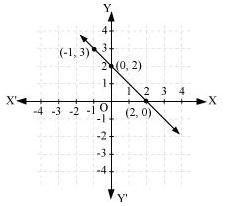
Points on the given line are (- 1, 3), (0, 2) and (2, 0). We may observe that coordinates of the points of the graph satisfies the equation y = - x + 2.
So y = - x + 2 is the equation corresponding to the graph shown in the second figure.
Hence,
So y = - x + 2 is the equation corresponding to the graph shown in the second figure.
Hence,
(iii) is the correct answer.
Solution 6
Let distance travelled by body and work done by body be d and w respectively.
Work done distance traveled
distance traveled
w d
d
w = kd
Where k is a constant
If constant force is 5 units, work done w = 5d
Now we may observe that point (1, 5) and (-1, -5) satisfy the above equation.
So (1, 5) and (-1, -5) are solutions of this equation.
The graph can be drawn as follows:
Work done
w
w = kd
Where k is a constant
If constant force is 5 units, work done w = 5d
Now we may observe that point (1, 5) and (-1, -5) satisfy the above equation.
So (1, 5) and (-1, -5) are solutions of this equation.
The graph can be drawn as follows:

(i) From the graphs we may observe that the value of y corresponding to x = 2 is 10. Thus the work done by the body is 10 units when the distance traveled by it is 2 units.
(ii) From the graphs we may observe that the value of y corresponding to x = 0 is 0. Thus the work done by the body is 0 units when the distance traveled by it is 0 unit.
(ii) From the graphs we may observe that the value of y corresponding to x = 0 is 0. Thus the work done by the body is 0 units when the distance traveled by it is 0 unit.
Solution 7
Let Yamini and Fatima contributed x and y repectively towards the Prime Minister's Relief fund.
Amount contributed by Yamini + amount contributed by Fatima = 100
x + y = 100
Now we observe that (100, 0) and (0, 100) satisfy the above equation.
So, (100, 0) and (0, 100) are solutions of above equation.
The graph of equation x + y = 100 can be drawn as follows:
Amount contributed by Yamini + amount contributed by Fatima = 100
x + y = 100
Now we observe that (100, 0) and (0, 100) satisfy the above equation.
So, (100, 0) and (0, 100) are solutions of above equation.
The graph of equation x + y = 100 can be drawn as follows:
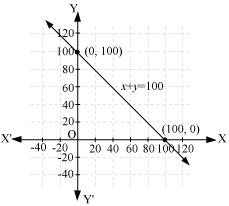
Here we may find that variable x and y are representing the amount contributed by Yamini and Fatima respectively and these quantities may not be negative. Hence we will consider only those values of x and y which are lying in 1st quadrant.
Solution 8
(i) 

We may observe that point (0, 32) and (-40, -40) satisfy the given equation. So these points are solutions of this equation.
Now we can draw the graph of above equation as below
Now we can draw the graph of above equation as below

(ii) Temperature = 30oC

So temperature is Fahrenheit is 86o F.
(iii) Temperature = 95o F
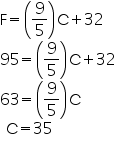
So temperature in Celsius is 35oC.
(iv)

So, if C = 0oC, F = 32o F
If F = 0o
If F = 0o
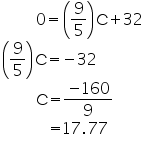
So if F = 0oF, C = - 17.8oC
(v)
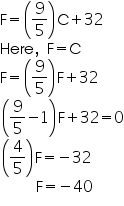
Yes there is a temperature - 40o which is numerically same in both Fahrenheit and Celsius.
Chapter 4 - Linear Equations in Two Variables Exercise Ex. 4.4
Solution 1
In one variable y = 3 represents a point as shown in following figure.

In two variables y = 3 represents a straight line passing through point (0, 3) and parallel to x axis. As it is a collection of all points of plane which are having their y coordinate as 3

In two variables y = 3 represents a straight line passing through point (0, 3) and parallel to x axis. As it is a collection of all points of plane which are having their y coordinate as 3
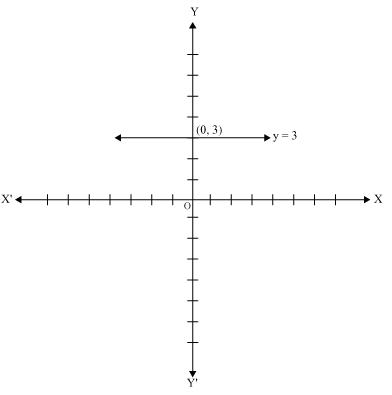
Solution 2
(1) In one variable 2x + 9 = 0 represents a point as shown in following figure.

(2) In two variables 2x + 9 = 0 represents a straight line passing through point (- 4.5, 0) and parallel to y axis. As it is a collection of all points of plane, having their x coordinate as 4.5.

(2) In two variables 2x + 9 = 0 represents a straight line passing through point (- 4.5, 0) and parallel to y axis. As it is a collection of all points of plane, having their x coordinate as 4.5.
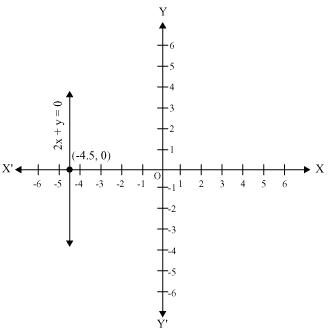
Comments
Post a Comment